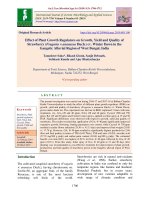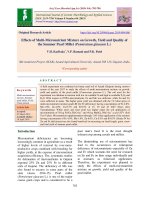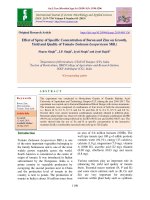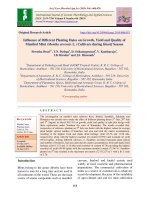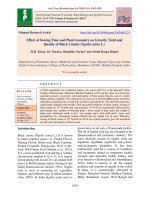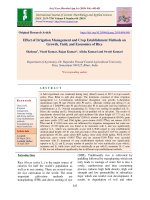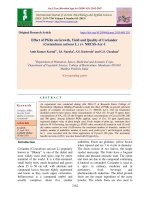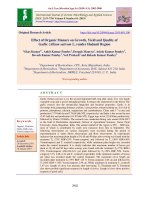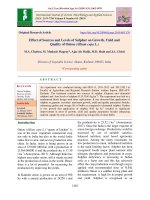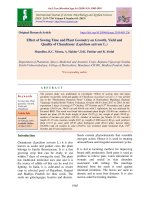Effect of PGRs on growth, yield and quality of coriander (Coriandrum sativum L.) cv. NRCSS-Acr-1
Bạn đang xem bản rút gọn của tài liệu. Xem và tải ngay bản đầy đủ của tài liệu tại đây (228.01 KB, 6 trang )
Int.J.Curr.Microbiol.App.Sci (2019) 8(5): 2162-2167
International Journal of Current Microbiology and Applied Sciences
ISSN: 2319-7706 Volume 8 Number 05 (2019)
Journal homepage:
Original Research Article
/>
Effect of PGRs on Growth, Yield and Quality of Coriander
(Coriandrum sativum L.) cv. NRCSS-Acr-1
Amit Kumar Kurmi1*, I.S. Naruka1, S.S. Kushwah2 and G.S. Chouhan2
1
2
Department of Plantation, Spices, Medicinal and Aromatic Crops,
Department of Vegetable Science, College of Horticulture, Mandsaur-458 001,
Madhya Pradesh, India
*Corresponding author
ABSTRACT
Keywords
Coriander, PGRs,
Growth, Yield,
Quality, Economics
of treatment
Article Info
Accepted:
17 April 2019
Available Online:
10 May 2019
An experiment was conducted during rabi 2016-17 at Research Farm, College of
Horticulture, Mandsaur (Madhya Pradesh) to study the effect of PGRs on growth yield and
quality of coriander (Coriandrum sativum L.) cv. NRCSS Acr-1. The ten treatments
included control (water spray), three concentrations of NAA (25, 50 and 75 ppm), three
concentrations of GA3 (10, 25 and 50 ppm) and three concentrations of Cycocel (100, 200
and 300 ppm). Among different PGRs applied, spray of GA3 50 ppm significantly
registered highest value of plant height (cm), Fresh weight of plant (g), minimum days
taken to 50 % flowering, test weight (g), SPAD value, essential oil content in seed (%) and
dry matter content in seed (%).However the maximum number of branches, number of
umbels, number of umbellets, number of seeds, seed yield (q ha -1) and biological yield(q
ha-1) were recorded with the foliar application of Cycocel 300 ppm. The maximum
benefit:cost ratio (4.05:1) was also found with 50 ppm GA3.
Introduction
Coriander (Coriandrum sativum L.) popularly
known as “Dhania’’ is one of the oldest and
most widely used seed spice crop by entire
mankind of the world. It is a thin-stemmed,
small bushy herb, much branched and grows
about 25 to 50 cm tall, with alternate and
compound leaves become highly segmented
and linear as they reach upper extremities.
Inflorescence is a compound umbel and
usually comprises about five smaller
umbellets. Fruits are globular, yellow brown
when ripened and are 3 to 4 mm in diameter.
The fruits consist of two halves, the single
seeded mericarps. The fruits have a fragrant
odour and pleasant aromatic taste. The odour
and taste are due to the compound containing
d-linalool or coriandrol. Coriander is used as
a spice, in culinary, medicine and in
perfumery,
food,
beverage
and
pharmaceuticals industries. The dried ground
fruits are the major ingredient of the curry
powder. The whole fruits are also used to
2162
Int.J.Curr.Microbiol.App.Sci (2019) 8(5): 2162-2167
flavour foods like pickles, sauces and
confectionary. The seed contain 18-21 per
cent fatty oil which is used in the cosmetic
industries. The young plants as well as the
leaves are used in the preparation of chutney
and are also used as seasoning in curries,
soups and sauces.
Use of plant growth regulators may be one of
the best possible way in affecting production
and productivity as they provide an
immediate impact on crop improvement
programmes and are less time consuming.
Gibberellic acid is found to induce stem and
internode elongation, flowering and fruit
setting and growth. Application of naphthalic
acetic acid (NAA) is also known to induce
higher physiological efficiency including
photosynthetic ability of plants. Plant growth
regulators leads also to better growth and
yield without substantial increase in the cost
of production. Therefore standardizations of
levels of growth regulators determine the
growth, yield and quality of coriander
(Haokip et al., 2016).
Materials and Methods
An experiment was conducted during rabi
2016-17 at Research Farm, College of
Horticulture, Mandsaur (Madhya Pradesh) to
see the effect of different plant growth
regulators on growth, yield and quality of
coriander. The soil of experimental field was
light black loamy in texture, with 7.2 pH, low
in available nitrogen (243.2 kg/ha), medium
in available phosphorus (19.75 kg/ha) and
high in available potassium (448.0 kg/ha).
The ten treatments tested include control
(water spray), three concentrations of NAA
(25, 50 and 75 ppm), three concentrations of
GA3 (10, 25 and 50 ppm) and three
concentrations of Cycocel (100, 200 and 300
ppm). These treatments were tested in
randomized block design with three
replications. The seed of coriander cultivar
NRCSS Acr -1 was sown on 20th October,
2016 keeping a row spacing of 30 cm and the
crop was harvested on 05th March, 2017. The
crop was fertilized with NPK @ 60:40:30kg
ha-1 as basal dose. Growth regulators were
applied at 30 DAS as foliar spray as per
treatments and untreated plots were sprayed
with water. The economics of treatment was
calculated on the basis of prevailing market
rates.
Results and Discussion
Growth attributes
The results revealed that application of PGRs
significantly improve vegetative growth of
coriander. Among different PGRs applied, 50
ppm GA3 recorded significantly maximum
plant height at 40 DAS (19.53 cm), 60 DAS
(54.73 cm) and at harvest (122.70 cm) fresh
weight of plant at 40 DAS (15.80 g), 60 DAS
(57.60 g), at harvest (46.34 g) and decreased
the days to 50 percent flowering (79.33 days).
Treatment CCC 300 ppm exhibited minimum
influence with respect to plant height at 40
DAS (10.07 cm), 60 DAS (38.80 cm) and at
harvest (103.13 cm) whereas the control
(water spray) exhibited maximum days to 50
percent flowering (93.33 days) and minimum
fresh weight of plant at 40 DAS (10.97 g),
60DAS (40.07 g), at harvest (30.08 g).
The 50 ppmGA3 treatment was found to be
more effective for influencing the vegetative
growth as evaluated by various parameters.
The increase in vegetative growth seems to be
due to enhanced cell division and cell
enlargement. Promotion of protein synthesis
by GA3 application exogenously might have
resulted in enhanced vegetative growth.
Similar results were reported by Singh et al.,
(2012) in coriander, Gour et al., (2010),
Bairva et al., (2012) in fenugreek and Abbas
(2013) in dill (Table 1).
2163
Int.J.Curr.Microbiol.App.Sci (2019) 8(5): 2162-2167
Table.1 Effect of PGRs on growth attributes of coriander
treatment
Plant height (cm)
Fresh weight of plant (g)
40 DAS
60 DAS
At harvest
40 DAS
60 DAS
At harvest
Number of
branches
plant-1
At harvest
T1 – Control
11.53
43.07
108.30
10.97
40.07
30.08
5.17
93.33
T2 – NAA @ 25 ppm
12.63
45.05
109.53
11.50
47.37
35.14
5.70
86.33
T3 – NAA @ 50 ppm
13.50
45.83
112.37
12.20
49.87
37.37
5.80
84.67
T4 – NAA @ 75 ppm
17.47
50.23
118.97
14.30
53.93
42.98
6.27
82.67
T5 – GA3 @ 10 ppm
14.10
46.63
114.43
12.03
50.20
36.17
5.77
85.67
T6 – GA3 @ 25 ppm
15.50
47.07
115.33
12.73
51.07
39.74
5.87
84.00
T7 – GA3 @ 50 ppm
19.53
54.73
122.70
15.80
57.60
46.34
6.77
79.33
T8 – Cycocel @ 100 ppm
10.77
42.27
105.57
11.13
44.77
34.49
6.30
91.00
T9 – Cycocel @ 200 ppm
10.23
40.93
104.30
11.60
47.33
36.87
6.37
89.67
T10 – Cycocel @ 300 ppm
10.07
38.80
103.13
11.93
48.20
37.15
7.20
89.33
S.Em.±
0.5379
1.0513
1.084
0.4582
0.9443
1.0636
0.1258
0.3635
C.D. at 5%
1.5983
3.1235
3.2208
1.3615
2.8056
3.1602
0.3736
1.0799
2164
Days to 50
percent
flowering
Int.J.Curr.Microbiol.App.Sci (2019) 8(5): 2162-2167
Table.2 Effect of PGRs on yield attributes and quality attributes of coriander
Treatment
Number Number Number Test
Seed
of
of
of seed weight yield
umbels umbellets umbel-1
(g)
(q
-1
-1
plant
umbel
ha-1)
T1 – Control
26.40
4.93
33.07
9.56
Biological Harvest SPAD Essential
Dry
Benefit:
yield (q
index
value
oil
matter
cost
ha-1)
(%)
content content
ratio
in seed in seed
(%)
(%)
11.17
34.62
32.33
37.67
0.33
80.14
3.10:1
T2 – NAA @ 25 ppm
31.60
6.20
35.43
10.03
11.85
35.83
35.95
40.27
0.34
84.72
3.26:1
T3 – NAA @ 50 ppm
32.53
6.40
36.93
11.28
13.28
37.53
38.01
41.06
0.43
85.78
3.68:1
T4 – NAA @ 75 ppm
34.73
7.03
41.27
12.05
14.26
40.32
37.79
42.25
0.47
88.01
3.93:1
T5 – GA3 @ 10 ppm
32.73
6.53
36.20
11.65
13.36
39.17
36.74
41.33
0.44
85.96
3.73:1
T6 – GA3 @ 25 ppm
34.27
6.80
40.07
11.90
14.15
38.97
38.89
41.51
0.45
86.24
3.76:1
T7 – GA3 @ 50 ppm
39.47
7.33
46.47
12.95
16.27
43.96
36.99
45.08
0.51
90.80
4.05:1
T8 – Cycocel @ 100
36.00
7.20
43.93
10.37
15.48
43.25
35.76
37.95
0.33
82.57
3.84:1
36.07
7.27
45.73
10.91
15.69
43.72
35.89
38.43
0.35
84.44
3.27:1
42.93
7.87
49.60
11.27
18.20
47.03
38.71
40.38
0.36
85.63
3.39:1
S.Em.±
1.1173
0.1556
0.9274
0.298
0.638
0.9851
1.3256
0.8079
0.0131
0.8796
3.10:1
C.D. at 5%
3.3198
0.4623
2.7555
0.887
1.898
2.92
NS
2.400
0.0388
2.6133
3.26:1
ppm
T9 – Cycocel @ 200
ppm
T10 – Cycocel @ 300
ppm
2165
Int.J.Curr.Microbiol.App.Sci (2019) 8(5): 2162-2167
Treatment CCC 300 ppm recorded the
maximum number of branches plant-1 (7.20)
while the minimum number of branches
plant-1 (5.17) was recorded in T1 (control).
The increase in number of primary branches
could be due to suppression of apical
dominance by the application of growth
retardant Cycocel which diverts the polar
transport of auxin towards the basal buds
there by leads to increased branching. These
results were in conformation with Vaidehi et
al., (2015), Haokip et al., (2016), Yugandhar
et al., (2016) in coriander, Bairva et al.,
(2012) in fenugreek and Rohamare et al.,
(2013) in Ajwain.
Yield and yield attributes parameters
The results revealed that application of PGRs
significantly improve yield and yield
attributes parameters of coriander except
harvest index (%). Among different PGRs
applied, 300 ppm CCC recorded significantly
maximum number of umbels plant-1 (42.93)
number of umbellets per umbel-1 (7.87)
number of seed umbel-1 (49.60) seed yield
(18.20q ha-1) biological yield (47.03q ha-1).
Among various PGRs used in the present
study the control (water spray) exhibited
minimum number of umbels plant-1 (26.40)
number of umbellets umbel-1 (4.93) number
of seed umbel-1 (33.07) seed yield (11.17q
ha-1) biological yield (34.62q ha-1). The
increase in number of umbels plant-1 could be
attributed due to the increase in the number of
both primary and secondary branches plant-1
with the application of Cycocel 300 ppm. The
increase in number of umbellets per umbel by
Cycocel might be due to accumulation of
metabolites which get translocated towards
the reproductive sinks and these in turn
resulted in stimulation of umbellets. The
increment in seed yield and biological yield
was significantly higher in Cycocel which
might be due to enhanced in growth and yield
attributes. The above results were in
conformity with the finding Meena et al.,
(2006), Kumar and Sundareswaran (2011),
Vaidehi et al., (2015), Haokip et al., (2016),
Yugandhar et al., (2016) in coriander.
Foliar application of GA3 50 ppm was
recording the maximum test weight, while the
minimum test weight was recorded with the
control (T1). Similar results were reported by
Panda et al., (2007), Singh et al., (2012) in
coriander and Meena et al., (2014) in
fenugreek (Table 2).
Quality parameters
The results revealed that application of PGRs
significantly improve quality parameters of
coriander. Among different PGRs applied,
GA350 ppm recorded significantly the
maximum SPAD value (45.08), essential oil
content in seed (0.51%) and dry matter
content in seed (90.80), while it was lowest
with the control (T1). The increment in SPAD
value, essential oil content in seed and dry
matter content in seed may be due to the
positive effect of GA3 50 ppm improved
overall growth and metabolism and also the
better translocation of carbohydrates and
utilization by the plant for good growth.
These findings are in close conformity with
the findings of Verma and Sen (2008), Singh
et al., (2012), Kuri et al., (2015), Vugandhar
et al., (2016) and Haokip et al., (2016) in
coriander.
The maximum benefit cost ratio was obtained
with 50 ppm GA3 treatment, compared to
other treatments.
References
Abbas, M.K. (2013). Effect of foliar fertilizer and
some growth regulators on Vgetative and
anatomical characters of dill (Anethum
graveolens L.). Middle- East Journal of
Scientific Research, 13(6): 803-811.
Bairva, M., Meena, S.S. and Mehta, R.S. (2012).
2166
Int.J.Curr.Microbiol.App.Sci (2019) 8(5): 2162-2167
Effect of bio-fertilizers and plant growth
regulators on growth and yield of
fenugreek (Trigonellafoenum- graecum
L.). International Journal of Seed Spices,
2(1): 28-33.
Gour, K., Patel, B.S. and Mehta, R.S. (2010).
Growth, yield and profitability of
fenugreek (Trigonellafoenum-graecum L.)
as influenced by varying levels of growth
regulators and vermin-wash. Journal of
Spices and Aromatic Crops, 19(1&2): 6567.
Haokip, C. M., Sharangi, A. B., Debbarma, k.,
Devi, A. K. R. and Karthik, C. S. (2016).
Role of plant growth regulators on the
growth and yield of coriander (Coriandrum
sativum L.). Journal of Crop and Weed,
12(3): 33-35.
Kumar, V.A. and Sundareswaran, S. (2011).
Effect of foliar application of chemicals
and growth regulator on growth and seed
yield in coriander (Coriandrum sativum
L.). Progressive Horticulture, 43(2): 193195.
Kuri, B. R., Jat, N. L., Shivran, A. C. and Puniya,
M. M. (2015). Productivity and
profitability
of
coriander
varieties
influence by sowing times and plant
growth regulators. Ann. Agric. Res. New
Series, 36(2): 204-211.
Meena, S. K., Jat, N.L., Sharma, B. and Meena,
V. S. (2014). Effect of plant growth
regulators and sulphur on productivity of
coriander (Coriandrum sativum L.) in
Rajasthan. International quarterly journal
of environmental sciences, 6: 69-73.
Meena, S.S., Sen, N.L. and Malhotra, S.K. (2006).
Influence of sowing date, nitrogen and
plant growth regulators on growth and
yield of coriander (Coriander sativumL.).
Journal of Spices and Aromatic Crops,
15(2): 88-92.
Panda, M.R., Chatterjee, R., Pariari, A.,
Chattopadhyay, P.K., Sharangi, A.B. and
Alam, K. (2007). Effect of growth
regulators on growth, yield and quality of
coriander. Indian Journal of Horticulture,
64(3): 369-371.
Rohamare, Y., Nikam, T.D. and Dhumal, K.N.
(2013). Effect of foliar application of plant
growth regulators on growth, yield and
essential oil components of ajwain
(Trachyspermum ammi L.). International
Journal of seed spices, 3(2): 34-41.
Singh, D., Singh, P.P., Naruka, I.S., Rathore, S.S.
and Shaktawat, R.P.S. (2012). Effect of
plant growth regulators on growth and
yield of coriander. Indian Journal of
Horticulture, 69(1): 91-93.
Vaidehi,
G.,
Kumar,
V.
M.
and
Veeraragavathatham, V. (2015). Effect of
plant growth regulators on different growth
parameters and yield of coriander
(Coriandrum sativum L.). International
Journal of Tropical Agriculture, 33(2):
1523-1525.
Verma, P. and Sen, N.L. (2008). The impact of
plant growth regulators on growth and
biochemical constituents of coriander
(Coriandrum sativumL.). Journal of Herbs,
Spices & Medicinal Plants, 14(3-4): 144153.
Yugandhar, V., Reddy, P. S. S., Sivaram, G. T.
and Reddy, D. S. (2016). Influence of plant
growth regulators on growth, seed yield,
quality and economics of coriander
(Coriandrum sativum L.) cv. Sudha.
Journal of Spices and Aromatic Crops,
25(1):13-17.
How to cite this article:
Amit Kumar Kurmi, I.S. Naruka, S.S. Kushwah and Chouhan, G.S. 2019. Effect of PGRs on
Growth, Yield and Quality of Coriander (Coriandrum sativum L.) cv. NRCSS-Acr-1.
Int.J.Curr.Microbiol.App.Sci. 8(05): 2162-2167.
doi: />
2167
